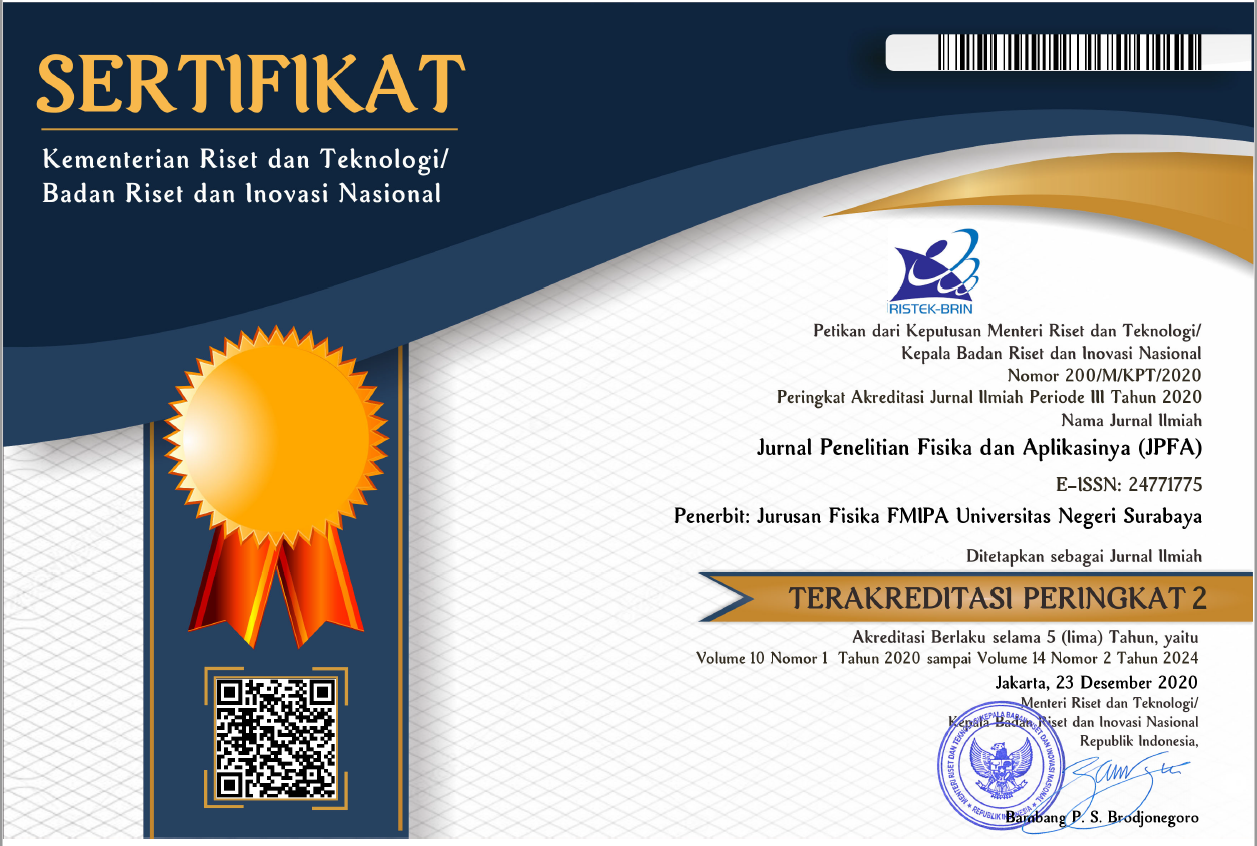ESTIMASI DURASI, ARAH DAN PANJANG RUPTURE SERTA LOKASI-LOKASI GEMPA SUSULAN MENGGUNAKAN PERHITUNGAN CEPAT
DOI:
https://doi.org/10.26740/jpfa.v1n2.p8-18Keywords:
Perhitungan cepat, durasi rupture, arah dan panjang rupture, peringatan dini tsunamiAbstract
Telah dilakukan penelitian untuk mengestimasi durasi rupture gempabumi yang terjadi dilautan Hindia (Aceh, Mentawai dan Jawa) yang selama ini dikenal rawan terjadi tsunami yang diakibatkan gempabumi. Kedua, untuk mengestimasi arah rupture dan lokasi-lokasi terjadinya gempa susulan. Estimasi durasi rupture gempabumi dikerjakan dengan menggunakan prosedur langsung, yaitu (1) memfilter seismogram kecepatan komponen vertikal yang direkam oleh jaringan IRIS-DMC dengan menggunakan filter Butterworth pada frekuensi tinggi (1 5 Hz), (2) melakukan picking waktu kedatangan gelombang P secara otomatis, (3) menentukan root mean square (RMS) dari amplitudo, (4) mengukur keterlambatan waktu kedatangan gelombang P pada 90% (T0,9), pada 80% (T0,8), pada 50% (T0,5) dan pada 20% amplitude (T0,2), dan (5) menghitung dan menampilkan hasil perhitungan durasi rupture secara cepat. Berdasarkan hasil analisis dalam riset ini dapat diketahui banwa durasi rupture gempabumi dapat diestimasi secara cepat (± 0,5 menit setelah gempa bumi terjadi) dan akurat. Selain itu, didapatkan informasi bahwa durasi rupture gempabumi memberikan informasi ekstra, yaitu jika durasi rupture gempabumi lebih besar atau sama dengan 50 detik, gempabumi tersebut berpotensi menimbulkan gempa bumi. Bahkan untuk gempabumi dengan tipe faulting-nya strike-slip bisa berpotensi menimbulkan tsunami jika durasi rupture-nya lebih besar dari 50 detik. Durasi rupture juga memberi informasi tentang arah dan panjang rupture, sehingga lokasi-lokasi yang berpeluang terjadi gempa bumi susulan dapat diestimasi.
References
Aydan, O., 2008. Seismic and tsunami hazard potential in Indonesia with a spacial emphasis on Sumatra island, Journal of The School of Marine Science ans Technology, Tokai University, 6 (3), 19-38.
Madlazim, Bagus Jaya Santosa, Jonathan M. Lees and Widya Utama, 2010. Earthquake Source Parameters at Sumatran Fault Zone: Identification of the Activated Fault Plane, Cent. Eur. J. Geosci, 2(4), 2010. DOI:10.2478/v10085-010-0016-5.
Madlazim, 2011a. CMT, Fault Plane and Rupture Duration for Earthquakes in Sumatra and Possibility of its Implementation for Tsunami Early Warning System, PhD Program of Technology Sepuluh Nopember Institute (ITS) Surabaya Dissertation
Madlazim, 2011b. TOWARD INDONESIAN TSUNAMI EARLY WARNING SYSTEM BY USING RAPID RUPTURE DURATIONS CALCULATION, INTERNATIONAL JOURNAL SCIENCE OF TSUNAMI HAZARDS, 4(30).
Baeda, A. Y., 2011. Seismic and Tsunami Hazard Potential in Sulawesi Island, Indonesia, Journal of International Development and Cooperation, Vol. 17, No. 1, 2011, pp. 17-30.
Brune, S., Babeyko, A.Y., Ladage, S., and Sobolev, S. V., 2010. Landslide tsunami hazard in the Indonesian Sunda Arc, Nat. Hazards Earth Syst. Sci., 10, 589604.
Kruger, F. and Ohrnberger, M., 2005. Tracking the rupture of the Mw 9.3 Sumatra earthquake over 1150 km at teleseismic distance, Nature, 435, 937939, doi:10.1038/nature03696.
Lay, T., Kanamori, H., Ammon, C. J., Nettles, M., Ward, S. N., Aster, R. C., Beck, S. L., Bilek, S. L., Brudzinski, M. R., Butler, R., DeShon, H. R., Ekstrom, G., Satake, K. and Sipkin, S., 2005. The great Sumatra- Andaman earthquake of 26 December 2004, Science, 308, 11271133.
Ishii, M., Shearer, P. M., Houston, H., and Vidale, J. E., 2005. Extent, duration and speed of the 2004 Sumatra-Andaman earthquake imaged by the Hi-Net array, Nature, 435, 933936, 2005.
Irsyam, M., Sengara, W., Aldiamar, F., Widiyantoro, S., Triyoso, W., Hilman, D., Kertapati, E., Meilano, I., Suhardjono, Asrurifak, M., Ridwan, M., 2010. Ringkasan Hasil Studi Tim Revisi Peta Gempa Indonesia 2010, Bandung.
Pribadi, S., 2008. Indonesia Tsunami Early Warning System for Disaster Mitigation,
Lomax, A., Michelini, A. & Piatanesi, A., 2007. An energyduration procedure for rapid determination of earthquake magnitude and tsunamigenic potential, Geophys. J. Int., 170, 11951209, doi:10.1111/j.1365-246X.2007.03469.x.
Lomax, A. & Michelini, A., 2009a. Mwpd: a duration-amplitude procedure for rapid determination of earthquake magnitude and tsunamigenic potential from P waveforms, Geophys. J. Int., 176, 200214, doi:10.1111/j.1365-246X.2008.03974.x.
Lomax, A. & Michelini, A., 2009b. Tsunami early warning using earthquake rupture duration, Geophys. Res. Lett., 36, L09306, doi:10.1029/2009GL037223.
Lomax, A. and A. Michelini, 2011. Tsunami early warning using earthquake rupture duration and P-wave dominant period: the importance of length and depth of faulting, Geophys. J. Int. 185, 283-291, doi: 10.1111/j.1365-246X.2010.04916.x.
Hara,T., 2007. Measurement of the duration of high-frequency energy radiation and its application to determination of the magnitudes of large shallow earthquakes, Earth Planets Space, 59, 227231.
Okal, E.A., 1988. Seismic parameters controlling far-field tsunami amplitudes: a review, Nat. Hazards, 1, 6796.
Geist, E. and Yoshioka, S., 1996. Source Parameters Controlling the Generation and Propagation of Potential Local Tsunamis, NaturalHazards 13: 151-177.
Gomez, J.M., Madariaga, R., Walpersdorf, A., and Chalard, E., 2000. The 1996 Earthquakes in Sulawesi, Indonesia, Bull. Seism. Soc. Am., 90, 3, pp. 739751.
Bilek, S. L. and Lay, T., 1999. Rigidity variations with depth along interplate megathrust faults in subduction zones, NATURE, Vol. 400, 29 July 1999, www.nature.com.
Geist, E.L. & Bilek, S.L., 2001. Effect of depth-dependent shear modulus on tsunami generation along subduction zones, Geophys. Res. Lett., 28, 13151318, doi:10.1029/2000GL012385.
Nakamura, Y., 1988. On the urgent earthquake detection and alarm system (UrEDAS), in Proc. of the 9th World Conference on Earthquake Engineering, Tokyo-Kyoto, Japan.
Downloads
Published
How to Cite
Issue
Section
License
Author(s) who wish to publish with this journal should agree to the following terms:
- Author(s) retain copyright and grant the journal right of first publication with the work simultaneously licensed under a Creative Commons Attribution-Non Commercial 4.0 License (CC BY-NC) that allows others to share the work with an acknowledgement of the work's authorship and initial publication in this journal for noncommercial purposes.
- Author(s) are able to enter into separate, additional contractual arrangements for the non-exclusive distribution of the journal's published version of the work (e.g., post it to an institutional repository or publish it in a book), with an acknowledgement of its initial publication in this journal.
The publisher publish and distribute the Article with the copyright notice to the JPFA with the article license CC-BY-NC 4.0.
 Abstract views: 1702
,
Abstract views: 1702
, PDF Downloads: 843
PDF Downloads: 843








